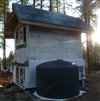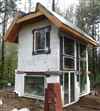Home Site Map - Steps - Basement Waterproofing and Deck -
Waterproofing Below Grade
Some of the steps for walls below ground are the same as for the walls above ground, eg the adding of EPS sheets. It is worth doing the parts of the wall that are below ground first as that lets the backfilling and landscaping round the building happen earlier.
This "below ground" step applies to any areas of ICF below grade and then it will continue up to a height level with the bottom of the basement windows and where necessary will follow the sloping grade about 3" above grade. Unlike the above grade case it needs to be 100% waterproof. It does not need to let the walls breath like needs to happen for above grade walls.
The layers
On the outside of the ICF goes a polyethylene sheet (with liquid membrane glue) and then two sheets of 2" EPS, then another polyethylene sheet, then 1" more of EPS, then a layer of dimple drainage board. Below grade the layers are stuck on rather than using screws because screws would mean holes through the waterproof sheets. Below ground things don't need to be particularly well held on because the backfilling will keep them in place. They just need to be held until the actual backfilling happens.
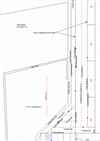
Make good the ICF
Repair ICF EPS
Prior to applying the EPS sheets it's important to repair any holes in the ICF EPS. Some holes will have been intentionally cut and some will be due to accidental damage. Fill big holes with pieces of scrap ICF EPS and use squirty foam in small holes.
Toilet bolts
Where there are wall mounted toilets in the basement there will be 5/8" studding through the concrete wall. Cut off the studding flush with the ICF surface. Dig away the ICF EPS and add a washer and nut. Tighten the nut down hard.
Clean around the slab outer perimeter
In practice the polyethylene sheeting up from the foundation will have been all trodden down and covered in mud and bits of polystyrene offcuts. It needs to be all cleaned up.
Ideally repair with single sided 2" tape any holes in the inner 6 mil polyethylene sheet, but it is not critical because the black liquid membrane will help seal around any holes.
Seal join between footing slab and ICF wall
This step happens at least a month after the ICF concrete pour, ie after the concrete has fully set. This cold joint is a weak link in the fight against water getting into the basement.
Need to cut away about 2" of ICF EPS on both the inside and outside of the wall at the bottom to expose the concrete.

Fill along the join with sealing mastic . It is ok that the mastic is not polystyrene safe because it is bare concrete.
![]()
Add horizontal EPS into cut slot
Cut 6.5" wide strips of 2" thick EPS sheet. Apply a decent quantity of liquid membrane along the corner edge that is closest to where the concrete cold joint is. The liquid membrane also helps hold the EPS in place. Note that the liquid membrane is safe for use with polystyrene.

Paint on liquid membrane
Paint on one complete layer of liquid membrane on the below grade ICF and horizontal EPS piece. Then it's dry, paint on another layer that will be used wet to stick on the Fab Form and inner polyethylene sheet.
Glue on inner plastic sheets
Glue FabForm
The first layer of plastic sheet is actually the FabForm sheet from the foundations. Apply waterproofing liquid membrane over the horizontal EPS strip and about a foot up the wall.

Press the FabForm onto the sticky black stuff.

Glue on inner polyethylene sheet
Apply waterproofing liquid membrane up the ICF wall to about 6" above where the grade line will be, ie to 6" above the backfill level. Even though its main function is to glue the polyethylene sheet to the wall, it is preferable to apply a full continuous coating (the photo below shows it only partially covered).

Press the inner polyethylene sheet onto the sticky black stuff.

The polyethylene sheet only needs to go to about 6" above grade so any excess can be cut off. Cut it off after the first layer of below grade EPS has been installed.

EPS Slab Triangles
Make triangle pieces
Cut 4 foot long pieces of EPS with the following widths for each triangular assembly: 8", 7.5", 5.5", 3.5". The last piece is 1.5" width, but you will be able to use a 45 degree cut scrap piece for that. You can use either liquid EPS glue or Foam Adhesive .
Details on the EPS can be found here .



Glue triangle pieces in place
They are glued with Foam Adhesive to the top of the EPS sheets that are now visible from the foundation. They go snugly up against the now covered horizontal EPS pieces added previously.

Bags of stones are a convenient way to hold them in place while the Foam Adhesive dries.
Fill in the corners and trim to make it a smooth corner.


Add first layer of 2" EPS to grade height
It is best to avoid any puncturing of the polyethylene waterproofing sheets that come from the foundations and go up the wall to grade height. Because of that it is best not to use screws below grade level. Once the backfilling has been done, the EPS sheets will be well held in place by the backfilled drainrock and soil. All that is necessary is to keep them in place until the actual backfilling happens. I use Foam Adhesive for gluing EPS to Polyethylene sheeting..
The below photos shows runs of Foam Adhesive but a better technique is to put wider spaced bigger blobs of foam.

Under windows leave a 2" gap under the window bucking box so there is room for the window sill EPS piece.
Wedge the bottom of the sheet against the EPS triangles. The top of the sheet if it's above grade can be secured with 4.5" long screws and plastic washers . Note that regular 3" screws are not long enough given the folds of polyethylene sheet under the EPS that typically cause it to bulge out a bit.





When the height of the backfilling exceeds about 3'6" then more creativity is required to keep the EPS sheets in place. This may involve better foam gluing and potentially incremental backfilling.
Glue EPS sheet above grade direct onto ICF
The first piece of the first layer of above grade EPS needs to be fixed on before the second layer of EPS sheet below grade so that the sheets can be staggered. Fix with regular 3" wood screws and plastic washers .
Above the grade level it is ok to use screws into the ICF webbing.

At the corners where the web is buried deeper it is necessary to use 5" long screws with plastic washers .
Use liquid EPS glue. Before applying the Liquid EPS Glue, mark the sheets with the locations of the ICF webbing (vertical lines) and also horizontally in sensible places so you don't try to screw between the bricks. It is best if the horizontal lines are the same across all sheets on a particular wall.

Liquid EPS Glue works well when gluing together two flat EPS surfaces.

Around the edges and in gaps it is best to use Foam Adhesive .



Glue second layer EPS sheet below grade

Use liquid EPS glue .
Fix with 6" screws and plastic washers .

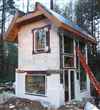
Where there are budges due to the Polyethylene sheets underneath, it is necessary to trim the corners square. Use a SurfForm for this. Put a bit of duct tape over the far end of the SurfForm so it can ride over the EPS surface as a guide to help get things square. Below grade it does not matter about budges because it will be hidden by the backfilling.

Add window sills
The drawings show the window sill pieces to be 10" wide. In practice cut them to be 9-3/4" wide (using a table saw) to allow for the thickness of the flashing round the windows.

Because of the window flashing thickness at the window corners it is necessary to shave off a bit of thickness to get the window sills to fit in. Use a SurfForm.

The window sill piece is glued into the slot under the window using foam adhesive. Use a square to check it is an accurate right angle to the wall. You may need to prop it up slightly while the Foam Adhesive is setting.

Foam around windows and doors
There will be an indented area around the windows. Fill this with Foam Adhesive .

After the foam has completely cured (next day), make it flush with the EPS using a kitchen knife and if needed a SurfForm.

Add grade level drip edges
An EPS drip edge shaped piece of EPS is used to accurately mark the transition from the below grade wall to the above grade wall. This is actually positioned with its bottom about 3" above the actual grade. The EPS pieces are cut on a table saw to be 3" x 2" and a 1.5" 45 degree bevel is cut using a hot wire cutter.
Start by drawing brick reference lines. The bricks go on a 9" x 3" grid and it is this grid that is used to position the grade drip edge. Start by drawing a horizontal line at the height of the underside of the window sill. Use a laser level or a spirit level to draw the horizontal reference line. Draw other horizontal lines below and above the reference line at 3" intervals. Mark the other lines at both ends by measuring relative to the reference line.

Decide where the grade drip edge will be. The grade will typically go up and down. When possible follow the grade using 6" steps, ie 2 brick grid heights. Between the drip edge pieces use 4" long EPS that is 1.5" x 1.5" cross section. The steps should be 9" from the edge for a full length brick. The brick pattern is offset by 4.5". So that means with the 3/8" mortar width, the brick depth is 4-1/8". You also need to allow for a 1/2" overlap at corners.
The drip edge pieces are glued on 3/8" below the chosen brick grid lines. Glue on the drip edge pieces using EPS liquid glue. Use 3" or 3.5" nails to hold them in place while the glue is drying.


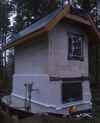
Where the drip edge pieces are directly below the window sill, there will be just a 3/8" gap between the bottom of the window sill and the top of the drip edge piece. Fill this with a strip of EPS that is cut to be 3/8" wide. Glue it in with EPS liquid glue.

Paint on more liquid membrane and fold up Polyethylene sheet
Paint on one complete layer. Then when its dry, paint on another layer that will be used wet to stick on the polyethylene sheet.



Remove wood stiffeners

Add 1" EPS protection layer
This last layer of EPS is mainly just to provide mechanical protection of the waterproofing Polyethylene sheet.
(The photos below show an additional layer of liquid membrane over the polyethylene sheet, but there is no point in doing this, particularly as it does not stick well to the polyethylene.)



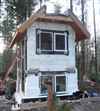
Fix in place dimple matt
Mel-Drain costs $142.77 per 4' by 50' piece. I buy from my local distributor (Cadman).


Fix the top edge of the drainmat using a 2" strip of Foam Adhesive . Note that this is just to hold it in place during the backfilling (after that it won't go anywhere).

Cut the drainmat to fit the profile formed by the drip edge grade pieces.

Use some Foam Adhesive on the corners and tape while it dries.

Backfill with crushed rock and earth
I use 1-1/4" clear crushed rock. This is bits of jagged rock that are on average about 1" width and has been washed to remove the file particles. It provides a good compromise between water flow through while locking together well structurally (ie not allowing the house to move laterally in an earthquake).

Add the crushed rock and soil incrementally on either side of the filter fabric so it balances to achieve a 1 foot width of crushed rock against the wall.

Even though not essential you may decide to filter stones from the soil. The main reason is you may want to use the stones for something else such as a pathway.

The crushed rock goes up to 1 foot below the polystyrene grade edging. Fold the filter fabric over the crushed rock. The last foot will be soil. The soil forms a fairly waterproof cap over the crushed rock.



Final layer of soil
Slope the soil away from the walls with a 5% slope. If needed by the terrain, implement a swale about 3 feet from the wall so the water has somewhere to run away.

If a water tank (to store rain water) is going to be installed, make a flat area.

On the flat area, put a layer of polystyrene down to act as a protection cushion.

